If your iPhone is indicating SOS badge at top-right corner of the screen, it usually means that your device is having problems connecting to network due to cellular connectivity issues.
If iPhone is showing “SOS Only” badge at top-right corner of the screen, it clearly means that your device is not at all connected to the network, but you will still be able to call emergency numbers like 911 (US) or 999 (UK).
SOS Only mode service is available in USA, Canada and some other countries and is designed to ensure that people are able to call emergency services, even if their device is not connected to a cellular network.
Why Does iPhone Switch to “SOS” & “SOS Only” Mode?
As mentioned above, iPhone goes into “SOS” or “SOS Only” mode, whenever it loses contact with the Carriers network and ends up losing its network connection.
This usually happens due to your device being located in an area with poor cellular reception, your Carriers network going through problems or not being available in that area.
Apart from this, iPhone can switch to “SOS mode” due to the SIM Card not being inserted properly, SIM Card becoming damaged/corrupted and other reasons.
Can iPhone Send Text Messages in SOS Only Mode?
An iPhone in “SOS Only” mode is not connected to the cellular network of your mobile service provider. Hence, you won’t be able to make calls or send text messages to regular phone numbers.
However, in the case of an emergency, you will be able to call 911 and other emergency services in your area.
How to Disable SOS Only Mode on iPhone?
Your iPhone should automatically come out of “SOS Only” mode, whenever the network strength improves or you move to an area with good cellular network connectivity.
If this is not happening, the problem could be due to other reasons and you need to go through the following troubleshooting steps.
1. Enable/Disable Airplane Mode
Enabling and Disabling Airplane Mode helps in refreshing cellular network and resetting wireless antennas on your device.
1. Open Settings > enable Airplane Mode by moving the slider to ON position.
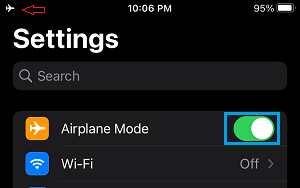
2. Wait for 30 seconds > Disable Airplane Mode by moving the slider to OFF position.
2. Restart iPhone
Restart your iPhone to rule out the possibility of the problem being due to stuck program or process preventing your device from connecting to cellular network.
1. Go to Settings > General > scroll down and tap on Shut Down.
2. On the next screen, switch OFF your device by moving the Slider to right.
3. Allow iPhone to completely power off > Wait for 30 seconds > Restart your device.
3. Disable Automatic Network Selection
Sometimes, the problem is caused due to your device trying to connect to other available networks.
1. Go to Settings > Cellular > Network Selection.
2. On the next screen, move the toggle next to Automatic to OFF position.
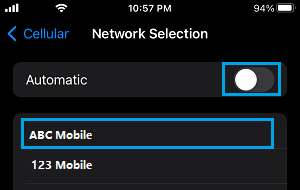
After disabling Automatic Network selection, wait for available Networks to appear on the screen and select your Service Provider’s Network.
4. Remove and Re-insert SIM Card
It is possible that your iPhone has lost contact with the Service Providers network due to its SIM Card being displaced, becoming faulty or damaged.
To check, remove the SIM Card from your iPhone and inspect the SIM Card for visible signs of damage.
If you do not find signs of damage, reinsert the SIM Card back into iPhone and see if the problem is now fixed.
5. Enable Roaming Data
If you are travelling or outside the area of your carriers network, you need to enable the Data Roaming option on your device.
Note: You need to be aware that roaming charges can be excessive and even turn out to outrageous in certain cases.
1. Go to Settings > Cellular > Cellular Data Options.
2. On the next screen, move the toggle next to Data Roaming to ON position (Green).
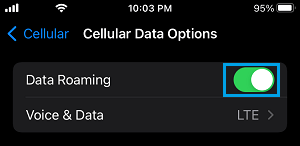
Once your device gets connected to the roaming network, it should come out of SOS Only mode.
6. Install iOS and Carrier Updates
Sometimes, iPhone can experience network connectivity issues due to an update waiting to be installed on your device.
1. Go to Settings > General > Software Update.
2. Wait for iPhone to check for updates > tap on Install (if an update becomes available).
8. Reset Network Settings
If above methods did not help, you can perform a Network Settings Reset on your device and see if this helps in fixing the problem.
1. Go to Settings > General > Transfer or Reset iPhone.
2. On the next screen, select the Reset option.
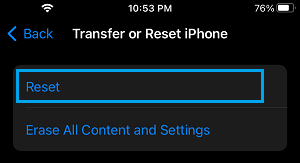
2. On the pop-up, tap on Reset Network Settings.
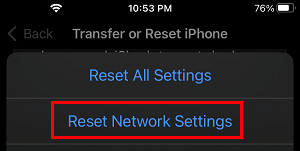
3. On the confirmation pop-up, tap on Reset to confirm.
After iPhone restarts, you will have to rejoin Wi-Fi Network by entering your WiFi Network Password.